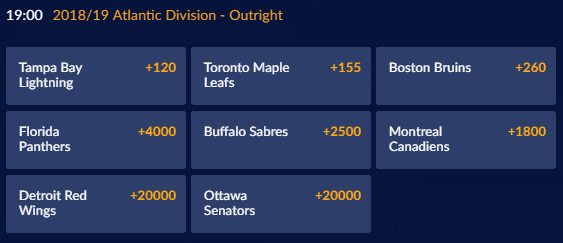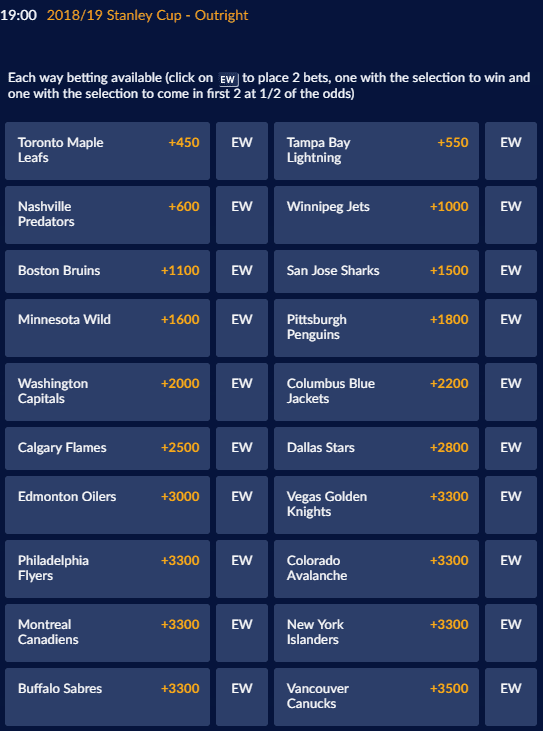How to Bet on Hockey
Hockey betting, particularly betting on the NHL, is one of the most popular and exciting sports to bet on, especially in Canada, where the average Canadian knows the ins and outs of the game like the back of their hand and quite often will have a rich knowledge of the team’s history, roster and statistics. If that describes you, and you’re also curious about betting on hockey, then this guide will give you an excellent primer before you make your first wager.

As is the case with betting on any sport, a smart bettor has a solid understanding of how odds work. To begin, let’s take a closer look at the most common type of bet in just about every sport: the moneyline.
Hockey Moneyline Betting
When you place a moneyline bet on hockey, you’ll see a series of numbers beside the team names that look something like this image below, in particular, the center column.
Let’s look at another example:

We’re going to be using this game between the Edmonton Oilers and the Montreal Canadiens. In the moneyline column, you can see the following numbers:
Montreal Canadiens +125
Edmonton Oilers – 145
This means that the Oilers are favored to win, as shown by the minus sign written in front of the 145, and the Canadiens are the underdogs, as shown by the plus sign in front of the 125.
What these numbers mean is that if you bet on the favorite, the Oilers, you will have to bet $145 to win $100, while if you put your money on the Habs, you’ll bet $100 to win $125.
The simplicity of this kind of bet is what has made it appealing to recreational and beginner sports bettors. For even more information about how these wagers work, check out our Moneyline Betting article in the Sports Interaction bet guide.
Hockey Puckline Betting
Puckline betting is hockey’s version of the runline in baseball. The puckline is the most popular form of hockey bet, and is essentially hockey’s version of the point spread. For the puckline in hockey games, which usually have lower score totals, the line is typically + 1.5 and – 1.5. This levels the playing field between the teams, which is how point spreads work.
The odds will look like this on the betting site:
Here’s another example of a game between Ottawa and Buffalo.

In the example above, Ottawa is the underdog, as indicated by the plus (+) sign in the puckline. These numbers mean that anyone betting on the Sens will win if they either win the game or don’t lose to Buffalo by more than 1.5 goals. The second number, 1.36, is the price – this means that if Ottawa wins or doesn’t lose by more than 1.5 goals, the bettor wins $1.36 for every $1.00 bet.
If you bet on Buffalo, they must win by more than 1.5 goals for the bet to win. In this event, the bettor wins $3.25 for every $1.00 bet.
Hockey Totals Betting
Much like moneyline and puckline, the Totals can be found on Sports Interaction in the following format:
And here’s another example for us to take a closer look at.

Once you can make sense of the basics, you can start looking into other NHL betting option, such as betting on the total number of goals scored in a game. In the above example, the sportsbook has set a an Over/Under of 5.5. Usually that Over/Under or Totals number will be set around 5 and 6.5 for NHL games, and you’re betting on whether the number of goals scored in that game will be more (Over) or less (Under) the listed number.
Toronto Maple Leafs Over +5.5 -115
Los Angeles Kings U +5.5 -105
In our example, if you want to bet on the over, you’ll have to risk $115 to win $100, while if you decide to bet on the Under, you’ll need to put down $100 to win $105.
To understand more about Over/Under and Totals betting, check out our complete guide.
Hockey Prop Betting

Prop bets, also known as proposition bets, are another way that hockey fans can wager on their team and it’s players, beyond just betting on whether or not the team will win or lose. In hockey, these kinds of bet include things like how many goals a specific player will score, or which player will score the first goal of the game.
Let’s take a look at the above example, using that game between the Oilers and the Canadiens. Connor McDavid has the best odds (-105) of scoring first. That means that if you bet on him to score first, your payout of $195 on a $100 bet would not be as high as it would be if you thought Artturi Lehkonen would be the first goal scorer. His odds are longer at (+320) meaning that your payout would be much higher. At +320, your $100 bet would earn you a $420 payout if Lehkonen netted the first goal.
Hockey Futures Betting

Futures betting is one of the higher risk bets you can make, but if you (and your team) are lucky, they can also end in very high payouts. This is particularly true if your team wasn’t expected to do very well in an upcoming season, and yet still managed to defy those odds to make a championship run. In our above example, which looks at the futures odds on the winner of the NHL Atlantic Division, you can see that the Tampa Bay Lightning and the Toronto Maple Leafs are in close contention as favorites to win the division. A $100 dollar bet on the +155 Leafs early in the season to win the division would earn you a total of $255.
Let’s take a look at one of the long shots on that list. The Ottawa Senators aren’t expected to do very well in their division for this season, so are priced at +20000 to win it. If you wanted to take a chance that the Sens could pull off a miracle and win the Atlantic, your $100 bet would earn you $20100.
Stanley Cup Betting
The big prize in the National Hockey League is of course, the Stanley Cup. After four best-of seven rounds between eight teams from each of the two conferences, the Stanley Cup final has the two conference champion teams play for Lord Stanley’s trophy. It’s a thrilling tournament and very popular with bettors. You don’t have to wait for the actual tournament to bet on the Stanley Cup however, thanks to futures betting. As soon as a Stanley Cup Champion is crowned, futures odds on next year’s potential winner are posted. As with most futures odds, because there are so many unknowns that could affect a team before and throughout the regular season, making a bet on the future winner is a calculated risk.

This example shows a selection of NHL teams and their odds to win the Stanley Cup, posted early on during the regular season. As you can see, the Maple Leafs are the current favorites to win the Cup, whereas other Canadian teams like the Canadiens, Oilers, Flames and Canucks are considered much longer shots. A $100 bet on the Vancouver Canucks pulling it off would win you $3600. The stakes are high, but the payoff for Stanley Cup betting can make it worth the risk.


